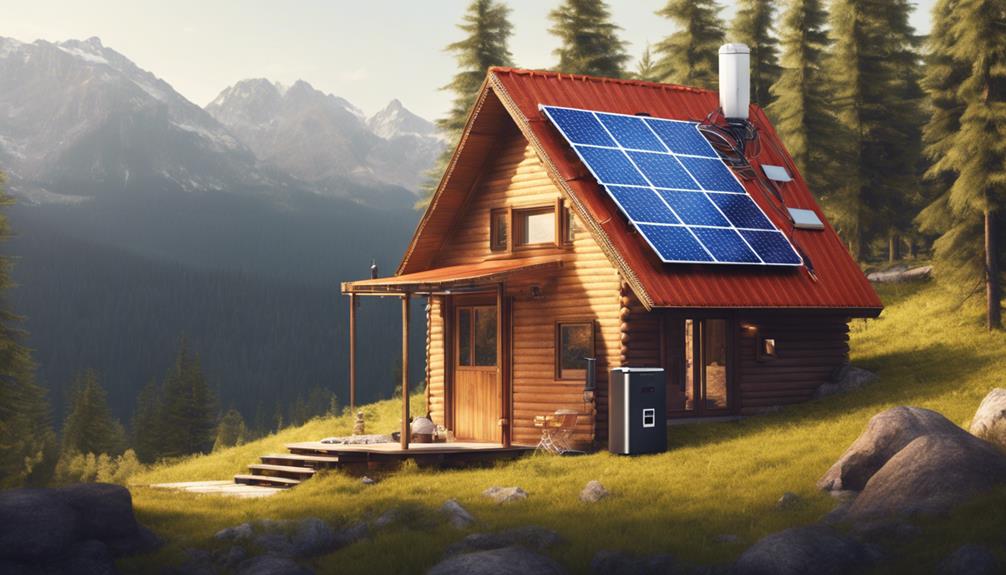When installing solar panels for your remote cabin, consider your energy needs and location. Calculate daily consumption, choose panels slightly exceeding needs, and size based on available space. Aim for optimal orientation to the sun with minimal shading. Mount panels securely, connect for desired output, and use a charge controller for battery regulation. Establish a cleaning schedule, weatherproof panels, and inspect regularly for optimal performance. Ensure proper maintenance to maximize longevity and efficiency. Understanding these key steps will set you on the right path for a successful solar panel setup for your remote cabin.
Choosing the Right Solar Panel System
When selecting a solar panel system for your remote cabin, consider the energy needs and location for optimal efficiency. Solar panel sizing is crucial to ensure you generate enough electricity to power your cabin. Calculate your daily energy consumption and choose panels that can produce slightly more to account for cloudy days. The size of your solar panels will also depend on the available space for installation on your cabin.
In addition to solar panel sizing, battery storage is another essential factor to consider. Batteries store excess energy generated by your solar panels for use during periods of low sunlight or at night. Opt for deep-cycle batteries designed for solar systems, as they're more effective at handling the charge-discharge cycles typical of solar power.
Ensure your battery storage capacity matches your energy consumption needs, allowing you to power your cabin even when the sun isn't shining. Properly sizing your solar panels and battery storage will help create a reliable off-grid power system for your remote cabin.
Assessing Your Cabin's Energy Needs
To determine the appropriate solar panel setup for your remote cabin, it's crucial to accurately assess your energy needs. Conducting an energy audit is the first step in understanding your power consumption patterns.
Calculate the total wattage consumed by your appliances, lighting, electronics, and any other electrical devices you use regularly. This assessment will provide you with valuable insights into the amount of electricity your off-grid living situation requires.
Optimal Placement for Solar Panels
Assessing your cabin's energy needs will guide you in determining the optimal placement for solar panels to maximize sunlight exposure and energy production efficiency. When considering panel orientation, aim for a south-facing direction in the Northern Hemisphere and north-facing in the Southern Hemisphere for the best sunlight exposure throughout the day. Avoid shading from nearby trees, structures, or terrain that can significantly reduce energy production. Regularly monitor shading patterns to adjust panel placement accordingly.
Seasonal angle adjustments are crucial for optimizing energy production. In the summer months, tilt panels closer to a vertical position to capture more direct sunlight. Conversely, in the winter, adjust the angle to be more horizontal to maximize exposure to lower-angled winter sun. Utilize adjustable mounting systems or periodically change panel angles manually to accommodate these seasonal variations.
Installation and Wiring Instructions
For successful installation and wiring of your solar panels, ensure that you have the necessary tools and equipment ready at your remote cabin.
Begin by mounting the solar panels on a sturdy structure facing the sun, ideally at a tilt to maximize sunlight exposure. Connect the panels in series or parallel to achieve the desired voltage and current output.
Next, install a charge controller to regulate the charging of your battery storage system, preventing overcharging or deep discharges.
When wiring your solar panels to the battery storage, use appropriate gauge wires to minimize energy loss. Ensure proper grounding to protect your system from electrical faults.
Additionally, consider integrating a backup generator into your setup to provide power during extended periods of low sunlight or high energy demand.
Regularly inspect and maintain your system to ensure optimal performance.
In the next section, we'll discuss maintenance tips for longevity.
Maintenance Tips for Longevity
Regularly inspecting your solar panel system is essential for ensuring its longevity and optimal performance. Establish a cleaning schedule to remove dirt, dust, and debris that can accumulate on the panels and hinder sunlight absorption. Ideally, clean the panels every 1-2 months or more frequently if you're in a particularly dusty area.
In addition to cleaning, weatherproofing your solar panels is crucial for their durability. Inspect the seals and connections for any signs of wear or damage. Make sure that all components are securely fastened and protected from the elements. Consider applying a weatherproof coating to vulnerable areas to prevent water damage and corrosion.
During your inspections, also check for shading issues caused by nearby trees or new obstructions. Trim any overhanging branches that may cast shadows on your panels.
Conclusion
Now that you have your solar panel system set up for your remote cabin, you can rest assured knowing that you have a reliable source of energy.
By assessing your energy needs, choosing the right system, and properly installing and maintaining it, you can enjoy the benefits of off-grid living.
Just remember to keep an eye on the weather forecast for optimal performance and efficiency.
Enjoy your eco-friendly energy solution!
